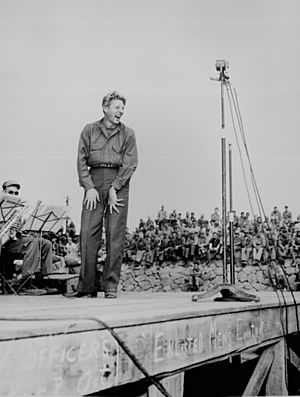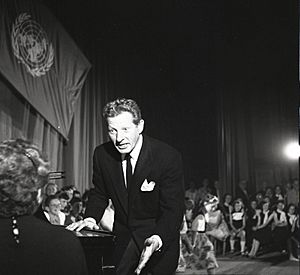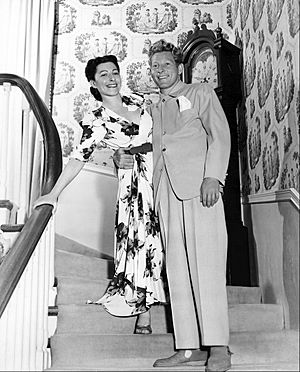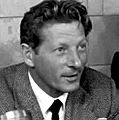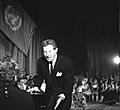Danny Kaye facts for kids
Quick facts for kids
Danny Kaye
|
|
|---|---|
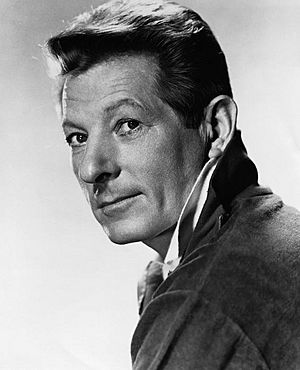 |
|
| Born |
David Daniel Kaminsky
January 18, 1911 New York City, U.S.
|
| Died | March 3, 1987 (aged 76) Los Angeles, California, U.S.
|
| Occupation |
|
| Years active | 1933–1987 |
| Political party | Democratic |
| Spouse(s) | |
| Children | 1 |
Danny Kaye (born David Daniel Kaminsky; January 18, 1911 – March 3, 1987) was a famous American actor, comedian, singer, and dancer. He was known for his funny physical comedy, unique pantomimes (acting without words), and super-fast songs.
Danny Kaye starred in 17 movies. Some of his most famous films include Wonder Man (1945), The Secret Life of Walter Mitty (1947), Hans Christian Andersen (1952), and White Christmas (1954). His movies were very popular, especially when he sang his fast "patter songs" or beloved tunes like "Inchworm".
Beyond acting, Danny Kaye was the first "ambassador-at-large" for UNICEF in 1954. UNICEF is a special part of the United Nations that helps children around the world. He received the French Legion of Honour award in 1986 for his many years of helping UNICEF.
Contents
Early Life and First Steps
David Daniel Kaminsky was born in Brooklyn, New York, on January 18, 1911. His parents, Jacob and Clara Kaminsky, were immigrants from Ukraine. Danny was the youngest of three sons. His older brothers were Larry and Mac. Danny was the only one of their children born in the United States.
He went to Public School 149 in Brooklyn, which was later renamed in his honor. Even then, he loved to entertain his classmates with songs and jokes. He also went to Thomas Jefferson High School but didn't finish.
When Danny was a teenager, his mother passed away. Not long after, he and a friend ran away to Florida. Danny sang while his friend played guitar, earning just enough to get by. When he returned to New York, his father let him explore his talents instead of pushing him to go back to school or work. Danny once said he wanted to be a surgeon when he was young, but his family couldn't afford medical school.
After leaving school, he had many different jobs. He worked as a soda jerk (someone who served drinks at a soda fountain), an auto insurance investigator, and an office clerk. He often got fired. One time, he lost an insurance job because of a mistake that cost the company a lot of money. Another time, a dentist hired him to look after his office. The dentist fired him when he found Danny using his dental drill on the office's wooden furniture!
In 1939, Danny met Sylvia Fine at an audition. She was the daughter of that same dentist! They got married in 1940. Danny learned many of his entertainment skills as a "tummler" (an entertainer who stirs up excitement) in the Catskills, a popular resort area.
Danny Kaye's first big chance came in 1933. He joined a dance group called the Three Terpsichoreans. They performed in Utica, New York, where he first used the stage name Danny Kaye. The group toured the United States and Asia. In 1934, while they were in Osaka, Japan, a huge typhoon hit the city. Their hotel was badly damaged. To calm the audience, Danny went on stage with a flashlight and sang every song he knew as loudly as he could.
This experience of trying to entertain people who didn't speak English helped him develop his famous pantomime gestures, songs, and funny facial expressions. Sometimes, he even used these skills to order food! His daughter, Dena, shared a story about her dad trying to order chicken in China. Danny flapped his arms and clucked like a chicken. The waiter understood and brought him two eggs! This trip also sparked his interest in cooking.
When Danny returned to the U.S., jobs were hard to find. He even worked in a show with a fan dancer named Sally Rand. His job was to make sure her fans were always held in front of her!
Danny Kaye's Career
In 1937, Danny Kaye made his first films. He signed a contract with Educational Pictures for a series of short comedies. He usually played a very energetic, fast-talking Russian character in these low-budget films. This series ended when the studio closed in 1938.
His next big step was a Broadway show called The Straw Hat Revue in 1939. His wife, Sylvia Fine, was the pianist, lyricist, and composer for the show. It only ran for 10 weeks, but critics noticed Danny's amazing talent. This led to an offer for Danny and Sylvia to perform at a New York City nightclub called La Martinique.
At La Martinique, a famous playwright named Moss Hart saw Danny perform. This led to Danny being cast in Hart's hit Broadway comedy, Lady in the Dark, in 1941. Danny, who was 30, was a huge success in the show. His most famous performance was "Tschaikowsky (and Other Russians)". In this song, he sang the names of many Russian composers incredibly fast, almost without taking a breath!
His first major movie was the 1944 comedy Up in Arms, filmed in Technicolor (which made movies look very colorful). The studio wanted him to dye his red hair blond because it looked better in Technicolor.
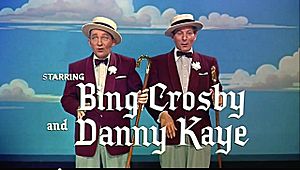
Danny Kaye also had his own radio show, The Danny Kaye Show, from 1945 to 1946. It became very popular. After World War II, he went on a USO tour to entertain soldiers. He was the first American actor to visit Tokyo after the war. He had been there before with his vaudeville group. Many episodes of his radio show still exist today, famous for his funny opening patter like "Git gat gittle, giddle-di-ap..."
Danny Kaye starred in many popular movies. Some of these include The Secret Life of Walter Mitty (1947), The Inspector General (1949), White Christmas (1954), and The Court Jester (1956). He also played real-life people in movies like Hans Christian Andersen (1952), about the Danish storyteller, and The Five Pennies (1959), about jazz musician Red Nichols. His wife, Sylvia Fine, wrote many of the tongue-twisting songs he was famous for.
When Danny Kaye performed at the London Palladium in 1948, he made the British Royal family laugh! It was said they even left their special box seats to watch him from the front row. He was invited back for a "Royal Variety Performance" later that year.
In 1952, he hosted the 24th Academy Awards (the Oscars), which was broadcast on radio. In 1953, Danny started his own movie production company, Dena Pictures, named after his daughter.
Danny Kaye started working in television in 1956. He hosted The Danny Kaye Show from 1963 to 1967. This show won four Emmy awards and a Peabody award, which are big honors in television. His last main movie role was in The Man from the Diners' Club in 1963.
From 1964, he also hosted the CBS TV broadcasts of MGM's The Wizard of Oz. He appeared on many other TV shows too. In the 1970s, he hurt his leg during a musical, but he kept performing, even using a wheelchair on stage!
In 1976, he played Geppetto in a TV musical of Pinocchio. He also played Captain Hook in a musical version of Peter Pan. Later, he appeared on The Muppet Show and The Cosby Show.
Danny Kaye was a talented actor, singer, dancer, and comedian. He also showed his serious side as an ambassador for UNICEF. He received two Academy Awards for his work, including the Jean Hersholt Humanitarian Award in 1982 for his charity work.
In 1980, Danny Kaye hosted the 25th anniversary of Disneyland and the opening of Epcot in 1982. Both were shown on TV.
Music Career
Even though Danny Kaye said he couldn't read music, he was known to have "perfect pitch," meaning he could recognize musical notes perfectly. He had a unique style, easily switching from funny novelty songs to soft ballads. In 1945, he started his own radio show where he sang many hit songs.
In 1947, Danny Kaye recorded songs with The Andrews Sisters, a famous singing group. They had a hit song called "Civilization (Bongo, Bongo, Bongo)." They continued to record together, making funny songs like "The Woody Woodpecker Song" and holiday favorites like "All I Want for Christmas Is My Two Front Teeth".
His first album, Columbia Presents Danny Kaye, came out in 1942. In 1950, his song "I've Got a Lovely Bunch of Coconuts" became another hit. After his movie Hans Christian Andersen (1952), two songs he sang, "Thumbelina" and "Wonderful Copenhagen", became popular.
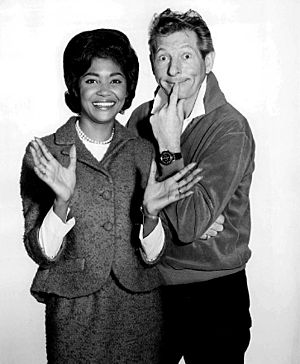
In the 1960s and 1970s, Danny Kaye often conducted famous orchestras, even though he couldn't read music. He learned the songs by listening! He was known for his funny antics while conducting, like trading his baton for a flyswatter. Famous conductors like Zubin Mehta and Dimitri Mitropoulos praised his conducting style. Mitropoulos, who led the New York Philharmonic Orchestra, once said, "Here is a man who is not musically trained, who cannot even read music and he gets more out of my orchestra than I have." Danny Kaye conducted symphonies to raise money for charity. He raised over $5 million for musician pension funds during his career.
Other Interests
Cooking
In his later years, Danny Kaye loved to cook at home. He was especially good at Chinese and Italian cooking. He even had a special Chinese restaurant kitchen built at the back of his house! He learned to cook from famous chefs and even taught Chinese cooking classes in San Francisco in the 1970s. A kitchen and dining area at the Culinary Institute of America in New York is named after him.
Danny Kaye was very enthusiastic about cooking. He once flew all the way to San Francisco just to get a sourdough bread recipe! But not all his cooking attempts went perfectly. After spending hours making sourdough loaves, his daughter asked about the bread. Danny hit a loaf on the kitchen table, and it was so hard it chipped the table!
Flying
Danny Kaye was also very interested in aviation and became a pilot. His friend, Michael Kidd, inspired him to learn to fly in 1959. Danny became qualified to fly many different types of aircraft, from small planes to large jets.
He even received a special license to fly a Learjet. The creator of Learjet, Bill Lear, made him an honorary vice president of the company. Danny Kaye used his flying skills to help UNICEF, once flying a Learjet to 65 cities in five days for the organization.
Baseball
Danny Kaye was a huge fan of the Los Angeles Dodgers baseball team. He even recorded a song called "The D-O-D-G-E-R-S Song." He was good friends with Dodgers manager Leo Durocher and often traveled with the team. He knew a lot about baseball and was a good second baseman himself.
In 1976, Danny Kaye and his business partner Lester Smith led a group that bought a new baseball team, the Seattle Mariners. They paid $6.2 million for the team. He later sold his share of the team in 1985.
Helping Others
Danny Kaye was an honorary member of important medical groups like the American College of Surgeons.
His work with UNICEF was very important to him. He helped teach people about children in need around the world and helped raise money and goods for them. His involvement with UNICEF started in an unusual way. In 1949, he was flying home from London when one of the plane's engines caught fire. The plane had to make an emergency landing. On the flight, he met Maurice Pate, the head of the Children's Fund, and they talked about the need to help children. This conversation started Danny's long and important connection with UNICEF.
Many people believe his greatest achievement was his tireless work for humanitarian causes. He was so connected to UNICEF that when the organization received the Nobel Peace Prize, Danny Kaye was chosen to accept it for them.
Personal Life
Danny Kaye and Sylvia Fine grew up in Brooklyn, living only a few blocks apart. However, they didn't meet until they worked on a show together in 1939. Sylvia was the audition pianist.
They got married in Fort Lauderdale on January 3, 1940. They were married for life, except for a short separation in 1947 and 1948.
Their only child, a daughter named Dena, was born on December 17, 1946. When Dena was very young, she didn't like watching her father perform because she didn't understand why people laughed at him. Danny Kaye said in an interview, "Whatever she wants to be she will be without interference from her mother nor from me." Dena grew up to become a journalist.
Danny Kaye was a Democrat and supported Adlai Stevenson in the 1952 presidential election. He was also the godfather to actress Mary Louise Weller.
In 2013, Danny's daughter Dena shared that her father was actually born in 1911, not 1913 as he sometimes said.
Health and Passing
In 1983, Danny Kaye had heart surgery. He later got hepatitis C from a blood transfusion. He passed away on March 3, 1987, at the age of 76, due to heart problems and hepatitis C.
Legacy
Danny Kaye was cremated, and his ashes were placed in the foundation of a bench at Kensico Cemetery in Valhalla, New York. His grave has a special bench with carvings of a baseball, an airplane, a piano, musical notes, and a chef's hat, showing his many interests.
The Sylvia and Danny Kaye Playhouse at Hunter College in New York was opened in 1988, thanks to a $1 million gift from Sylvia Kaye.
While some of his TV work might seem a bit old-fashioned now, his movies like White Christmas and The Court Jester are still loved today. The Court Jester is even considered one of the greatest comedies of all time!
Honors and Awards
- Danny Kaye was knighted by Queen Margrethe II of Denmark in 1983. He received the cross of the Knight of the Dannebrog for his work with UNICEF and his connection to Denmark. He had played Hans Christian Andersen in a movie.
- He was made a Chevalier of the French Legion of Honor in 1986 for his work with UNICEF.
- In 1987, after his passing, he was given the Presidential Medal of Freedom by President Ronald Reagan. His daughter Dena accepted the award.
- In 1988, he was added to the American Theater Hall of Fame.
- UNICEF created the Danny Kaye International Children's Award in his honor. This was a children's European singing competition held each year from 1988 to 1992.
Other Awards and Recognition
- Golden Globe Award for Best Actor – Motion Picture Musical or Comedy in 1951 for On the Riviera.
- Received an honorary Academy Award Oscar in 1955 for his unique talents and service to the film industry.
- Golden Globe Award for Best Actor – Motion Picture Musical or Comedy in 1958 for Me and the Colonel.
- The first person to receive the Lions Clubs International Foundation's Humanitarian Award in 1973–74.
- Jean Hersholt Humanitarian Award in 1981.
- An asteroid, 6546 Kaye, was named after him.
- He has three stars on the Hollywood Walk of Fame for his work in music, radio, and films.
- Received a Kennedy Center Honor in 1984.
- Was the Grand Marshal of the Tournament of Roses Parade in 1984.
- UNICEF's New York Visitor's Centre is named in his honor.
- A street in San Antonio, Texas, is named after Danny Kaye.
- His career and his wife Sylvia's work are remembered in The Danny Kaye and Sylvia Fine Collection at the Library of Congress. This collection includes scripts, photos, and recordings.
- In 1986, Danny Kaye was crowned King of Brooklyn at the Back to Brooklyn Day Festival.
Filmography
Film
| Title | Year | Role | Director | Co-stars | Notes |
|---|---|---|---|---|---|
| Dime a Dance | 1937 | Eddie | Al Christie | Imogene Coca, June Allyson | Short film |
| Getting an Eyeful | 1938 | Russian | Short film | ||
| Cupid Takes a Holiday | Nikolai Nikolaevich | William Watson | Short film | ||
| Money on Your Life | Nikolai Nikolaevich | Short film | |||
| Up in Arms | 1944 | Danny Weems | Elliott Nugent | Dinah Shore, Dana Andrews | First feature film |
| I Am an American | Himself | Crane Wilbur | Humphrey Bogart, Joan Leslie | Short film | |
| Wonder Man | 1945 | Edwin Dingle/Buzzy Bellew | H. Bruce Humberstone | Virginia Mayo, Vera-Ellen | |
| The Kid from Brooklyn | 1946 | Burleigh Hubert Sullivan | Norman Z. McLeod | Virginia Mayo, Vera-Ellen | |
| The Secret Life of Walter Mitty | 1947 | Walter Mitty | Norman Z. McLeod | Virginia Mayo, Boris Karloff | |
| A Song Is Born | 1948 | Professor Hobart Frisbee | Howard Hawks | Virginia Mayo, Benny Goodman | |
| It's a Great Feeling | 1949 | Himself | David Butler | Doris Day, Jack Carson | Cameo appearance |
| The Inspector General | Georgi | Henry Koster | Walter Slezak, Elsa Lanchester | ||
| On the Riviera | 1951 | Jack Martin/Henri Duran | Walter Lang | Gene Tierney | |
| Hans Christian Andersen | 1952 | Hans Christian Andersen | Charles Vidor | Farley Granger | |
| Knock on Wood | 1954 | Jerry Morgan/Papa Morgan | Norman Panama Melvin Frank |
Mai Zetterling | |
| White Christmas | Phil Davis | Michael Curtiz | Bing Crosby, Rosemary Clooney | ||
| The Court Jester | 1956 | Hubert Hawkins | Norman Panama Melvin Frank |
Glynis Johns, Angela Lansbury | |
| Merry Andrew | 1958 | Andrew Larabee | Michael Kidd | Pier Angeli | |
| Me and the Colonel | Samuel L. Jacobowsky | Peter Glenville | Curt Jürgens | ||
| The Five Pennies | 1959 | Red Nichols | Melville Shavelson | Barbara Bel Geddes, Louis Armstrong | |
| On the Double | 1961 | Private First Class Ernie Williams/General Sir Lawrence MacKenzie-Smith | Melville Shavelson | Dana Wynter, Margaret Rutherford | |
| The Man from the Diners' Club | 1963 | Ernest Klenk | Frank Tashlin | Cara Williams | |
| The Madwoman of Chaillot | 1969 | The Ragpicker | Bryan Forbes | Katharine Hepburn |
Television
- The Secret Life of Danny Kaye (1956) (TV special)
- The Danny Kaye Show (1963–1967) (TV series)
- The Lucy Show: "Lucy Meets Danny Kaye" (1964) (guest appearance)
- Here Comes Peter Cottontail (1971) (voice role)
- Pinocchio (1976) (TV musical, as Geppetto)
- Peter Pan (1976) (TV musical, as Captain Hook)
- The Muppet Show (1978) (guest appearance)
- Disneyland's 25th Anniversary (1980) (special guest)
- Skokie (1981) (TV movie)
- The Wonderful World of Disney Official Opening of Epcot Center (1982) (host and conductor)
- The Twilight Zone: "Paladin of the Lost Hour" (1985) (guest appearance)
- The Cosby Show: "The Dentist" (1986) (guest appearance)
Stage Work
- The Straw Hat Revue (1939)
- Lady in the Dark (1941)
- Let's Face It! (1941)
- Two by Two (1970)
Selected Music
Albums
- Danny Kaye (1949)
- Hans Christian Andersen (Soundtrack, 1952)
- White Christmas (Soundtrack, 1954)
- The Five Pennies (Soundtrack, with Louis Armstrong, 1959)
Popular Songs
- "Bloop Bleep" (1947)
- "Civilization (Bongo, Bongo, Bongo)" (with The Andrews Sisters, 1947)
- "The Woody Woodpecker" (with The Andrews Sisters, 1948)
- "I've Got a Lovely Bunch of Coconuts" (1950)
- "Thumbelina" (1952)
- "Wonderful Copenhagen" (1953)
- "D-O-D-G-E-R-S Song (Oh, Really? No, O'Malley)" (1962)
Images for kids
See also
 In Spanish: Danny Kaye para niños
In Spanish: Danny Kaye para niños


